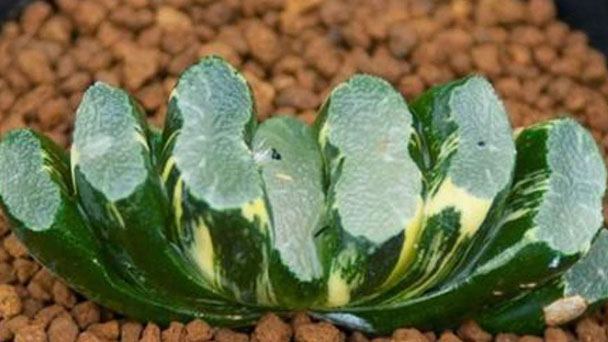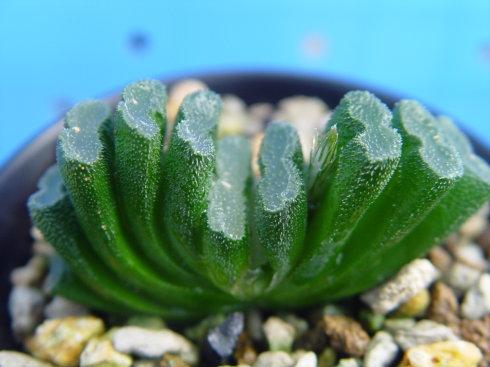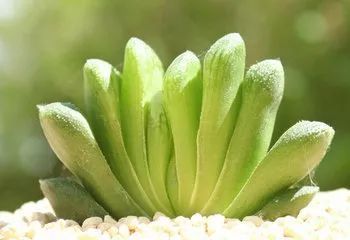How to grow Haworthia truncata Schonland
Written by Maggie
Jan 26 2021

How does the Haworthia truncata Schonland, one of the most valuable of the succulents, be kept with the scalloped tip of the plant as if it had been cut in half? To begin with, watering, lighting, temperature, fertilizing, and changing the basin, these five points will surely make the Haworthia Truncata Schonland grow rapidly.

Haworthia Truncata Schonland Care
1. Water properly
The root of the haworthia truncata Schonland is a fleshy root capable of storing a large amount of water and nutrients, which means that it is drought-tolerant and waterlogged. The principle of watering it is "dry and well watered". Water once a week in spring and autumn. Water can be poured 2 ~ 3 times a week in the summer high temperature season. In winter, as long as the soil is moist and watered once a month is no problem.
2. The light
Truncata Schonland of Haworthia does not need much sunlight for its growth, and it is usually appropriate to place it in places where sunlight scatters adequately. Especially in the summer, it needs to be properly shaded. In winter, you can receive 3 to 5 hours of direct sunlight every day. If there is insufficient sunlight, the Haworthia Truncata Schonland will grow and grow, affecting its ornamental value.
3. Control the temperature
The temperature suitable for the growth of Truncata Schonland of Haworthia ranges from 12 ℃ to 32℃, and if the temperature exceeds 32℃, it will enter into dormanence and stop growing. Dormancy also occurs if the temperature falls below 12℃. During the dormant period of Truncata Schonland of Haworthia, it is necessary to reduce the amount of watering, or even not water at all, to avoid root rot.
4. Apply fertilizer rationally
Succulents don't really need much fertilizer because they have a great store of nutrients themselves. To fertilize Truncata Schonland of Haworthia, it is better to use thin fertilizer frequently, once every half a month, and to buy fleshy love fertilizer from flower shops. This kind of fertilizer is relatively expensive, so don't use other fertilizers randomly.
5. Replace pots and trim roots
Generally speaking, it is necessary to replace the basin-soil of the jade fan every two years. After two years, the soil will become more solid, and the nutrients in it will be absorbed by the Haworthia Truncata Schonland almost as much. Use a larger pot with more fertile, loose soil. The root rot in the root system can be pruned during the basin-changing process, so that the Haworthia Truncata Schonland can better absorb nutrients.

Trunccata Schonland of Haworthia Propagation
1. Sow and reproduce
The method of truncata Schonland seeding and propagation of Haworthia is cumbersome and time-consuming, and is not recommended here. Seeds of truncata Schonland of Haworthia were sown on an appropriate seedbed and then covered with a thin film, which acted as a heat and moisture barrier and promoted germination, generally in about 7 to 10 days.
2. Leaf insertion and propagation
At the base of the plant of Truncata Schonland of Haworthia, a robust, semi-lignified leaf was selected and placed in a cool, well-ventilated place to dry the wound. It is then inserted into a matrix of sandy soil mixed with perlite, which only needs to be slightly moist. It is then cured at a temperature of 20 ~ 25℃ and rooted approximately 3 ~ 4 weeks later.
3. Root insertion and propagation
Root insertion is suitable for basin-changing and a robust root system can be removed from the base of the parent plant of the Haworthia Truncata Schonland. Then it is buried in the soil in the upper end of the surface of the soil exposed about a centimeter. After a while, new buds will sprout on the top of the root system, and then new jade fan plants will grow.
4. Plant separation and propagation
The plant separation method is also more suitable for the basin. The young specimens of Truncata Schonland of Haworthia can be removed and placed in a cool, well-ventilated place to dry the wound before planting. After planting, you can adapt to the environment and grow normally within a week.

Common pest and disease control of Truncata Schonland Haworthia
Insects and diseases of Truncata Schonland of Haworthia are rare, and the common infestation is a few bites from some starworms. Basically in daily maintenance it will not encounter pests and diseases. The most vulnerable damage is due to rotten roots and leaves resulting from improper watering, and the need to avoid the accumulation of water in the leaves of the Haworthia Truncata Schonland during watering.
To protect against pests and diseases, use chili or garlic water. Watering the potted soil of the Haworthia Truncata Schonland once a month was effective in preventing the invasion of pests, and also improved the immunity of the plants of the Haworthia Truncata Schonland.
Latest Updated
- Benefits of Bugleweed - 7 Science-backed Health Benefits
- Bugleweed Dangers & Side Effects - Is It Poisonous?
- How to Plant Evergreen Trees - What You Should Know
- When to Plant Evergreens - Grow Guide for Evergreen Trees
- 12 Wonderful Evergreen Shrubs for Your Garden
- 12 Popular Evergreen Plants with Pictures for Beginners
- When And How To Prune A Lilac Bush Like a Pro
- How to Grow & Care for Lilac Vine (Hardenbergia Violacea)
- Japanese Lilac Tree (Syringa Reticulata) Care & Propagation Guide
- Shumard Oak Pros and Cons - What to Know
Popular Articles
- Winter maintenance of Antirrhinum Majus
- How to Grow Terminalia Mantaly Tree
- How to Grow and Care for Crossostephium Chinense
- How to grow Antirrhinum Majus in spring
- Peristeria Elata (Dove Orchid) Profile: Info & Care Guide
- Underwatered Snake Plant (Sansevieria Trifasciata) - Signs And How To Fix
- How to Care for Brazilian Jasmine Plant (Mandevilla Sanderi)
- How to Grow & Care for Graptopetalum Purple Delight in Summer
- Rosa Chinensis (China Rose): Plant Growing & Care Tips
- How to Care for Baby Sun Rose (Aptenia Cordifolia)